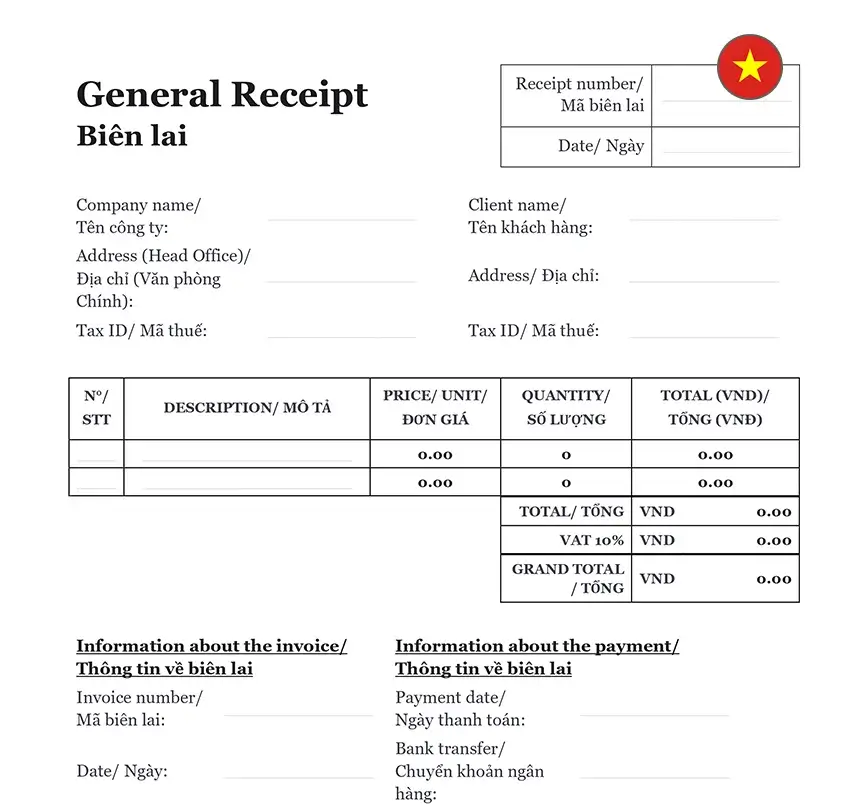Ready to use legal template
Work on without any hassle
Vietnamese-English translation
Ready to use legal template
Work on without any hassle
Vietnamese-English translation
Home › Accounting › General receipt
Learn more about General Receipt in Vietnam
A General Receipt is a formal document that acknowledges the receipt of money, goods, or services from one party to another. It serves as an important proof of transaction for individuals and businesses alike, ensuring transparency and accuracy in financial dealings. In Vietnam, issuing a general receipt is a practical way to record payments for various purposes, such as deposits, reimbursements, partial payments, or one-time transactions. It helps both the payer and the recipient maintain clear and verifiable records that may be required for accounting, audits, or legal purposes. Whether you’re running a small business, managing a nonprofit, or handling personal transactions, having a reliable and clear receipt format is essential. Download our General Receipt, easy to edit in Word format and professionally drafted in both English and Vietnamese.
Table of contents
What is a General Receipt?
A General Receipt, in essence, functions as a versatile acknowledgment of transactional exchanges between parties, offering a blanket acknowledgment of receipt without delving into the specifics of the items or payments involved. This document serves as a crucial record of the transfer of goods, services, or monetary funds, providing clarity and confirmation to both parties involved in the transaction. Its broad applicability makes it a valuable tool in various scenarios, whether in business transactions, personal exchanges, or legal agreements, where a formal acknowledgment of receipt is necessary but without the need for detailed itemization.
With its flexibility and simplicity, a General Receipt stands as a fundamental component of transparent and accountable dealings between parties. By providing a clear record of receipt without the burden of exhaustive detail, it streamlines the documentation process while ensuring the integrity and legality of the transaction. Whether utilized for cash payments, product deliveries, rental agreements, or other exchanges, a General Receipt offers a concise yet comprehensive record, facilitating smoother transactions and minimizing disputes or misunderstandings between parties involved.
What is included in a General Receipt?
A General Receipt typically includes essential information pertaining to the transaction, although the specifics may vary depending on the context and the requirements of the parties involved. Here’s a general overview of what may be included:
Date and Time: The date and time when the receipt is issued, providing a timestamp for the transaction.
Details of the Parties: Names and contact information of both the payer (person or entity making the payment) and the recipient (person or entity receiving the payment).
Description of Payment or Items: A brief description of the payment made or the items received, although this may be more general compared to specific receipts.
Amount Received: The total amount of money received or the value of the items received, expressed in the relevant currency or units.
Method of Payment: Information about how the payment was made, whether in cash, check, credit card, electronic transfer, or another method.
Signature: Signatures of both the payer and the recipient, if applicable, to acknowledge the receipt and confirm the transaction’s completion.
Witness or Notary: In some cases, a witness or notary may also sign the receipt to further authenticate the transaction, depending on legal requirements or the parties’ preferences.
Including these details ensures that the General Receipt serves as a comprehensive record of the transaction, providing clarity and accountability for both parties involved.
Why is a General Receipt important?
A General Receipt holds significant importance for several reasons:
| ➤ Documentation: It serves as official documentation of a transaction, providing evidence that a payment has been made or items have been received. This documentation is crucial for record-keeping purposes, accounting, and financial management. |
| ➤ Legal Protection: A General Receipt can offer legal protection to both parties involved in a transaction. It helps establish proof that a transaction occurred and outlines the terms and conditions agreed upon, which can be valuable in resolving disputes or misunderstandings. |
| ➤ Financial Transparency: By acknowledging the receipt of payment or items in a formal manner, a General Receipt promotes financial transparency and accountability. It ensures that both parties are aware of the transaction details and can refer back to them if needed. |
| ➤ Verification of Transactions: For businesses, General Receipts are essential for verifying transactions and reconciling financial records. They provide a paper trail that helps track income, expenses, and inventory, facilitating accurate financial reporting and decision-making. |
| ➤ Customer Confidence: Providing customers or clients with a General Receipt instills confidence in the transaction process. It demonstrates professionalism, reliability, and a commitment to transparency, which can enhance customer satisfaction and trust in the business or individual. |




